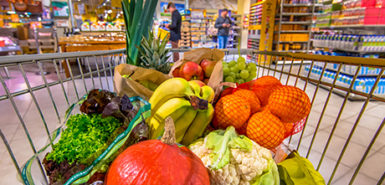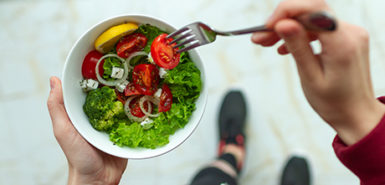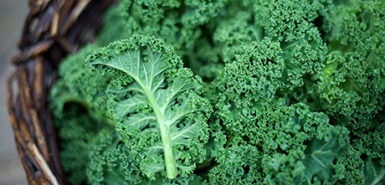
Many Americans eat too much overly processed food.
Cookies, potato chips, soda, fast food meals, boxed cereal, canned soups—even granola bars and packaged bread.
So how do we cut back? And why should we bother, anyway?
Spectrum Health dietitian Kristi Veltkamp, RD, can answer those questions and provide some tips to help you identify processed foods—and learn how to eat healthier and feel better.
What is processed food?
Most foods in the grocery store are processed in some way, whether they’re cleaned, chopped, cooked, canned or frozen.
And that’s not necessarily a bad thing, Veltkamp said. There are different levels of processed food, from minimally processed to ultra-processed.
Minimally processed foods—bagged spinach that’s already washed and ready to use, for example, or fruits and vegetables that have been prepared, bagged and frozen—can actually be a great addition to your diet if they encourage you to eat more fruits and vegetables, she said.
“You’re still getting the food in its natural state, but they haven’t added or taken anything away, they have just prepped it for you,” she said. “Some people get nervous about anything in a package, but sometimes it can be better.”
One example is frozen vegetables. If they’re not in season locally, the frozen version can actually have more nutrients than the fresh, which has been traveling great distances and sitting out for long periods of time.
Frozen vegetables are flash-frozen right after they’re picked for optimal freshness.
“Frozen broccoli might be the better choice in February,” she said.
But then there’s ultra-processed food, which is a different story, Veltkamp said. This is when the nutritional value of the food is altered.
Take, for instance, refined flour. Food processors strip away the bran and germ, which is where the fiber, vitamins and minerals are found. This leaves just starch. Then, in many processed foods, other things are added in, such as preservatives, salt, sugar, chemicals and artificial ingredients.
“What you’re left with can be something that isn’t really food,” Veltkamp said.
Why is ultra-processed food bad for us?
The first problem is what we’re not getting from overly processed food—all the essential nutrients we need from our food, Veltkamp said. Without those vitamins, minerals and fiber, our bodies cannot function as well.
It affects our immune system, compromises gut health, increases inflammation and has even been linked to increased risk of cancer in some studies. It also causes fluctuating blood sugar levels throughout the day.
Because many ultra-processed foods are high in sugar, fat, salt and carbohydrates, they can lead to obesity, Veltkamp said.
Also, it’s not just your imagination—these foods really are addictive and can even make you hungry for more since they are not as filling.
“You could eat a bag of potato chips, and then not feel like you ate anything,” Veltkamp said. “But if you eat a baked potato, you will get full fast.”
Processed foods are absorbed quickly into the body and they don’t process the way more natural foods do.
“They have done the work that our bodies are supposed to do,” Veltkamp said.
Research has shown that sugar and salt are addictive, as they trigger the release of dopamine and serotonin, the brain chemicals that make us want more reward.
“We get addicted to it because we want to feel good,” she said. “You just want to eat more. So your brain is saying, ‘This is great. Keep going.’ And your stomach is telling you you’re not full.”
How can I cut back on ultra-processed food?
Veltkamp encourages everyone to keep it simple and take small steps toward natural, real food.
Here are some tips:
1. Move toward less processed whenever possible.
Be aware of how processed your food is and take one step at a time from ultra-processed to less processed. For instance, if you eat packaged, frozen meals, look for those with healthy, real food ingredients.
“They have more healthy meal options, even in the frozen section, with brown rice or quinoa and stir fry veggies,” she said.
2. Read labels.
Look for real food ingredients and know what’s in your food. For example, if you’re buying bread, look for the first ingredient to be whole grain wheat flour.
“The word ‘whole’ is critical,” she said. Also look for ingredients that are recognizable and ingredient lists that are shorter, rather than longer.
3. Think about adding in healthy food rather than just taking away unhealthy food.
Veltkamp encourages people to think about adding in more fruits and vegetables, rather than just taking away processed food.
If your main dish is processed chicken nuggets, have a baked potato and salad with it. When you’re ready for more of a challenge, try making chicken nuggets from scratch with boneless chicken breasts and breadcrumbs.
Make sure the majority of your meal is “good stuff,” she said. Veltkamp likes to follow the 80-20 rule— about 80% of your diet as real whole foods, and then 20% fun.
4. Don’t forget about snacks, dessert and drinks.
Focus on eliminating processed foods from the extras throughout your day.
“Most people do decent with their meals, and the majority get off track with snacks and desserts between meals,” Veltkamp said.
Try to replace chips and cookies with veggies or fruits that are convenient to grab and go. Or choose whole grain crackers instead of highly processed ones.
Try to drink as much water as possible, rather than sugary drinks or diet sodas with artificial sweeteners. Water infused with fruits (cucumber, lime, strawberry and more) add flavor and variety without a lot of sugar.
5. Be mindful of where you buy your food.
When you’re shopping for groceries, focus on the perimeter of the store, where most of the fresh and minimally processed food is located. Of course, frozen fruits and vegetables and some canned or packaged foods from the store aisles are important and can be healthy, as well.
If you’re looking to get closer to the food source, branch out from the produce at your local grocery store by visiting a farmer’s market or roadside stand, or invest in a share in a community supported agriculture farm.
Stock your refrigerator and pantry with fresh, whole foods and then experiment with some new recipes.
Then, sit back and watch the benefits as you feel better and your health improves.
 /a>
/a>
 /a>
/a>
 /a>
/a>
I really appreciate articles that educate and encourage such as this one! It is very helpful, and just a really good reminder too for those you already know the basics. Thank you!